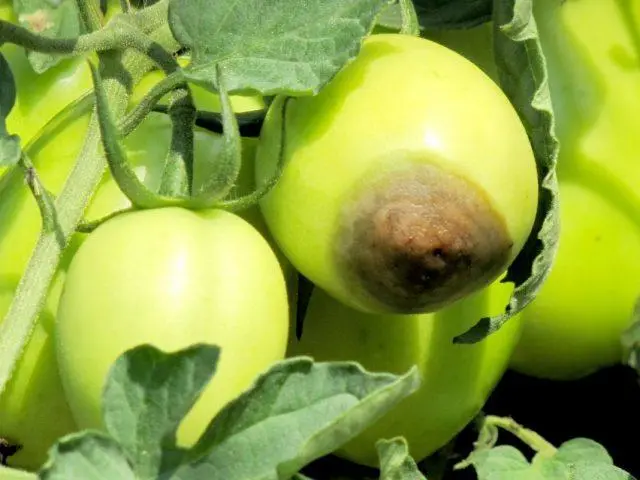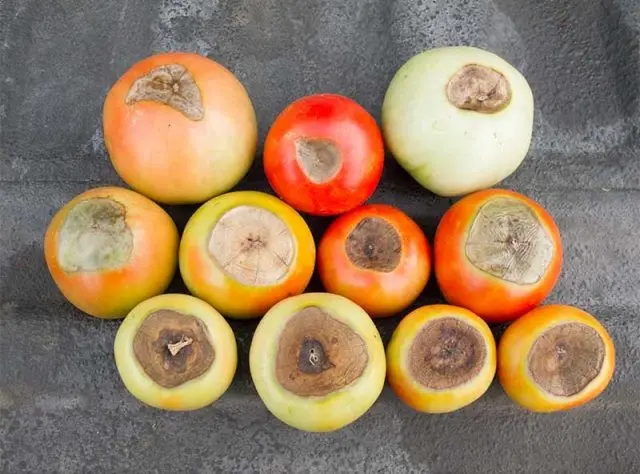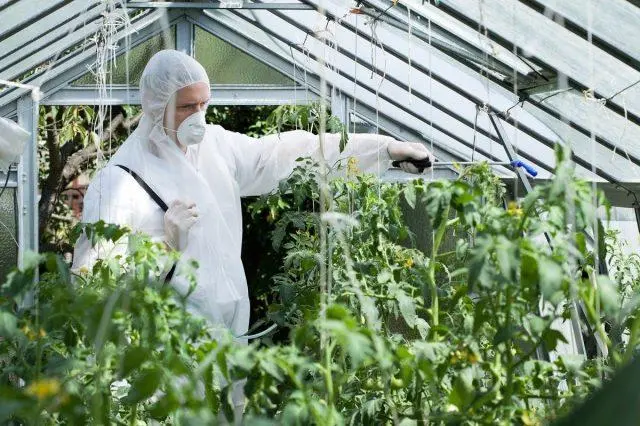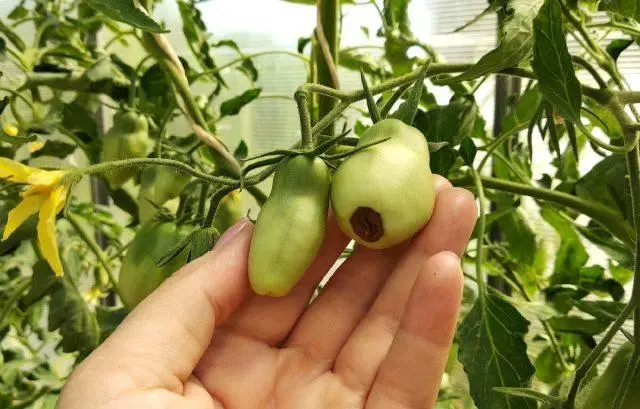Contents
Blossom end rot on tomatoes in a greenhouse is a fairly common crop disease that every gardener has encountered at least once in his life. It is manifested by the formation of a rotten spot in the upper part of the tomatoes, spoiling the presentation and taste of the fruit. Such a vegetable becomes unsuitable for canning, and with a strong lesion and for eating.

Blossom rot can sometimes be referred to as top, black, or top rot.
What is this disease
Blossom end rot is a physiological disease that manifests itself only on the tomato fruits themselves and does not affect the plant. Outwardly, the culture bushes look healthy, the fruits are tied normally, their shape is correct. But over time, a dry spot appears on the top of the vegetable, gradually increasing in size.
If we compare this disease with late blight, then it is not caused by fungi and is in no way associated with pathogenic factors. Most often it is the result of improper care of tomatoes and can occur both in the beds in the open field and in the greenhouse.
The disease does not occur annually. But if it appeared in a greenhouse, then, most likely, all the beds will be exposed to it. In this case, the losses can be quite significant. This is not only found on tomatoes, top rot can affect peppers, cucumbers, eggplants. If it is detected in time, then vegetables can be saved and, with the organization of proper treatment, the formation of new ovaries and healthy fruits can be achieved.
Causes of appearance
The main reason why top rot occurs on tomatoes is non-compliance with the rules of agricultural technology. The disease can appear due to a lack of nutrients, especially calcium and boron. With a lack of the first, the cell wall of the skin of the vegetable deteriorates and collapses, which leads to its deformation, and with a lack of the second, the first cannot be absorbed normally.
Blossom rot also appears at high temperatures and insufficient moisture. If the growing region is northern, then this factor leads to the disease only in the greenhouse. In southern latitudes, heat and drought provoke vertex rot in open beds.
Signs of infection
Blossom rot on tomatoes can appear in a dry form, in particular on green fruits and in the form of weeping spots (bacterial) without limiting boundaries. The first signs of infection can be recognized by the unhealthy tips of the tomato. The spots on them may have a depressed or flat appearance, their color is initially green, but as the disease develops, it becomes brown or even black. The size may be small, but over time increase and capture most of the fetus. Diseased tomatoes stop growing and begin to ripen quickly.
If the disease occurs due to a lack of calcium or due to the high acidity of the soil, then spots can be seen on all fruits, and if heat becomes the cause of the disease, then, in particular, specimens growing on the first three hands are affected.
Sometimes vertex rot has a latent form. That is, it does not appear outwardly, but is diagnosed on a section of tomato tissue. The pulp of the fruit becomes hard.

Blossom rot makes tomatoes firm and dry.
What is dangerous disease
The main danger of the disease is the loss of the crop. Tomatoes affected by blossom end rot in the greenhouse and in the garden stop developing, become deformed, become tasteless and unsuitable for use. When the disease penetrates the fruits, they quickly rot and fall off the bushes.
Measures to combat blossom end rot of tomatoes in the greenhouse
Top rot on tomatoes in a greenhouse and in the open field is treated the same way. The faster you see and identify the disease, the more chances the gardener has to save the crop and defeat the disease.
There are several methods of struggle, their description is presented below.
Agrotechnical methods
Among the agrotechnical measures to protect tomatoes from blossom end rot in the greenhouse and on the site, crop rotation is distinguished. It is undesirable to plant tomatoes in the place where they and other nightshade crops grew before. It takes at least three years to wait. You need to grow tomatoes on moisture-intensive soil, and add soddy soil and peat to too light soil. Before sowing seeds, treat them with disinfectants. For example, soak for 30 minutes in a solution of potassium permanganate. As soon as the fruits begin to appear on the bushes, inspect them regularly, and if dark spots are found, immediately pluck and dispose of them.
Folk remedies
At the initial stage of the disease on tomatoes in the greenhouse and beds, you can try to get rid of it with folk methods. The most effective remedies are prepared as follows:
- Ash decoction. Ash in the amount of 300 g is sifted, poured into 1 liter of water, boiled over low heat for 15 minutes. The resulting solution is filtered, diluted in a bucket of water and used for spraying tomatoes in the greenhouse and on the street.
- Calcium chloride. The drug purchased at the pharmacy is diluted with water (10 liters will be needed per 10 ml ampoule). The resulting solution is used to irrigate the bushes at least three times with an interval of two weeks.
- Eggshell. A sufficient amount of the product is put in a jar, filled with water and infused for about five days. The resulting mixture is filtered, brought to a volume of 3 liters, used for spraying.
- Soda ash. Add 1 tbsp to a bucket of water. l. product, mixed, used for processing the green mass of tomatoes in the greenhouse and in open areas, on any land, except for carbonate.
- Chalk. In 5 liters of water, add 250 g of building or fodder chalk, stir, irrigate the bushes during the growing season.
Chemicals
Blossom rot is often treated with chemicals. To protect the site and the greenhouse, they usually use:
- Calcium nitrate. Its solution is suitable for root and foliar treatments. The tool is prepared from a bucket of water and 2 tbsp. l. drug. It is suitable for processing both young and adult bushes.
- Brexil Sa. The agent is diluted in accordance with the instructions supplied by the manufacturer. The plot and the greenhouse are treated once every ten days.
- Lime nitrate. In 10 liters of water, dissolve 8 g of the drug and irrigate the tomatoes with the resulting composition every four days.
- A mixture of 10 liters of water, 10 g of calcium nitrate and 10 g of boric acid.

Wear a mask and gloves when working with chemicals
Biopreparations
Top rot of tomatoes is well treated with biological preparations such as Fitosporin and Calcifol 25. They are quickly absorbed by plants and are considered completely harmless.
Phytosporin, in addition to treating this disease, protects the culture from various fungal infections. Prepare it by mixing 10 g of the substance and 1 liter of water. For treatment with Calcifol, it is dissolved in an amount of 50 g in a bucket of liquid.
Prevention of blossom end rot of tomatoes in the greenhouse
Than to deal with blossom end rot on tomatoes in a greenhouse, it is easier to prevent its occurrence, for which it is desirable to carry out a number of preventive procedures. These are the following activities:
- Monitoring soil moisture levels in greenhouses and gardens. Do not allow the soil to dry out, but at the same time do not flood the beds. Watering should be carried out at least once a week exclusively in the mornings or evenings.
- Organization of loosening beds after each moistening. In the case when the tomato is not grown in a greenhouse, the procedure is carried out after rain.
- Soil mulching. It helps the earth retain moisture for longer.
- Pasynkovanie plants and regular weeding beds. Tomato plantings should be ventilated, so they should not be allowed to thicken, especially in a greenhouse.
- Regular feeding. Tomatoes should be fertilized with mineral complexes according to the recommended schedule.
- Cleaning the greenhouse or beds after the full harvest. With the advent of autumn, you need to get rid of all plant debris, as well as carry out deep digging of the earth.
- Sowing green manure to improve soil structure.
- Preparing the greenhouse for winter.

Blossom rot appears less often if the soil is deoxidized
Sustainable varieties
In order to encounter the disease as little as possible, experts recommend planting varieties with maximum resistance to it in greenhouses and soil. Usually these varieties include those that have late ripening dates. In addition, in recent years there have been bred varieties with increased resistance to the disease, even when grown in adverse conditions. These are tomatoes Summer resident (Dachnik), Crown (Venec), Pharaoh (Faraon), Moon (Lunniy), Raisa (Raisa).
Conclusion
Blossom rot on tomatoes in the greenhouse, as well as in the open field, can be removed by taking certain measures to treat it. If a disease is detected, you should not rush to dig up the bushes, if you organize wellness activities correctly, you can completely get rid of the disease. But, according to experts, rather than looking for a solution to a problem that has already arisen, it is better not to allow it to appear at all, for which you just need to properly care for tomatoes and systematically carry out preventive procedures.









